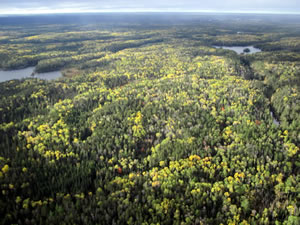Iconic Minnesota conifers may give way to a more broad-leafed forest in the next century

“Minnesota Forest Ecosystem Vulnerability Assessment and Synthesis” was published by the U.S. Forest Service’s Northern Research Station and is available online at: http://www.nrs.fs.fed.us/pubs/45939
The assessment describes effects of climate change that have already been observed; projected changes in the climate and the landscape; and forest vulnerabilities in a 23.5-million-acre region of forest in northeastern Minnesota.
Tree species that are already at the southern end of their range, such as balsam fir, quaking aspen, white spruce, and tamarack, are expected to decline over the next century while American basswood, black cherry, eastern white pine, red maple, sugar maple, and white oak may gain suitable habitat across the landscape.
“By planning ahead, foresters and other decision-makers can begin now to manage for resilient landscapes and ensure that the benefits that forests provide are sustained into the future,” said Michael T. Rains, Director of the Northern Research Station and the Forest Products Laboratory. “Forest Service science is delivering information and new technology that will help managers in Minnesota and throughout the nation meet this challenge.”
Changes in Minnesota’s climate have been documented over the past century. In general, the state is experiencing less snowfall in the area covered by the assessment, but more severe winter storms. Mean, minimum, and maximum temperatures have been increasing across all seasons, with winter temperatures experiencing the most rapid warming. Precipitation in the spring and fall has increased, with more of that precipitation occurring in deluges of 3 inches or more.
What might these changes mean for forests?
- The projected temperature increases will lead to longer growing seasons in the assessment area.
- The number of heavy precipitation events will continue to increase in the assessment area, and impacts from flooding and soil erosion may also become more damaging.
- Forests may experience more drought stress during the growing season.
- Climate conditions will increase fire risks by the end of the century.
- Many invasive species, insect pests, and pathogens could increase or become more damaging.
“There are so many variables that will affect the future of forests in northern Minnesota, forest managers will probably always have to deal with some amount of uncertainty,” said Stephen Handler, lead author of the vulnerability assessment and a climate change specialist with the Northern Institute for Applied Climate Science (NIACS). “But we already know enough right now to begin planning for a range of possible futures. Our assessment gives forest managers in Minnesota the best possible science on the effects of climate change, so they can make climate-informed decisions about management today.”
More than 30 scientists and forest managers contributed to the assessment, which is was conducted as part of the Northwoods Climate Change Response Framework, a collaboration of federal, state, academic, and private partners led by the NIACS. NIACS is a collaboration of the Forest Service, Michigan Technological University, The Trust for Public Land, and the National Council for Air and Stream Improvement. The Climate Change Response Framework and this assessment are local examples of information provided by the new USDA Climate Hubs and the Forestry Sub-Hub located in Houghton, Mich. http://www.usda.gov/oce/climate_change/regional_hubs.htm
xxxx
The mission of the U.S. Forest Service is to sustain the health, diversity, and productivity of the nation’s forests and grasslands to meet the needs of present and future generations. The USDA agency has either a direct or indirect role in stewardship of about 80 percent of our nation’s forests, amounting to 850 million acres including 100 million acres of urban forests gracing the nation’s cities, where 80 percent of Americans live. The mission of the Forest Service’s Northern Research Station is to improve peoples’ lives and help sustain the natural resources in the Northeast and Midwest through leading-edge science and effective information delivery.
USDA is an equal opportunity provider and employer. To file a complaint of discrimination, write: USDA, Office of the Assistant Secretary for Civil Rights, Office of Adjudication, 1400 Independence Ave., SW, Washington, DC 20250-9410 or call (866) 632-9992 (Toll-free Customer Service), (800) 877-8339 (Local or Federal relay), (866) 377-8642 (Relay voice users).
Media Contact
All latest news from the category: Agricultural and Forestry Science
Newest articles

New model of neuronal circuit provides insight on eye movement
Working with week-old zebrafish larva, researchers at Weill Cornell Medicine and colleagues decoded how the connections formed by a network of neurons in the brainstem guide the fishes’ gaze. The…

Innovative protocol maps NMDA receptors in Alzheimer’s-Affected brains
Researchers from the Institute for Neurosciences (IN), a joint center of the Miguel Hernández University of Elche (UMH) and the Spanish National Research Council (CSIC), who are also part of…

New insights into sleep
…uncover key mechanisms related to cognitive function. Discovery suggests broad implications for giving brain a boost. While it’s well known that sleep enhances cognitive performance, the underlying neural mechanisms, particularly…



